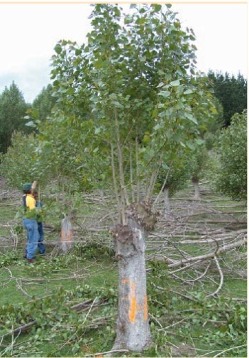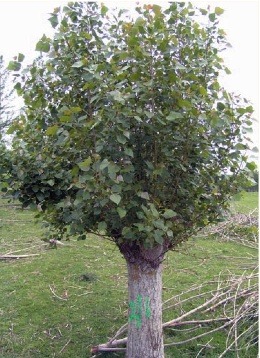Poplar fodder trial
Murray Harris & Barrie Wills , New Zealand Tree Grower February 2005.
John and Heather Prebble have been farming for 20 years at Mt Blue. This is 630 hectares of mainly sheep and beef 10 km inland from Palmerston, or approximately 15 km due west of the Pacific Ocean. The area experiences a great range in climate with rainfall on average being 650 mm a year, but it is not uncommon for it to fall as low as 400 mm every 8 or 10 years. However there have been recordings of annual rainfall as high as 1000 mm.
Severe droughts can affect the greater East Coast of North Otago and Canterbury, and when they impact on an area it can take considerable time for the district to recover. Soil erosion and impacts on groundwater can be a major problem. One of the real farming issues in a drought is the lack of feed after Christmas, in particular not having sufficient feed to fatten stock as well as providing additional nutrients for the ewes prior to tupping.
Special fodder block plantings
The Otago Catchment Board in the late 1980s had been very active in highlighting and promoting the concerns and long-term impacts that droughts had on the coastal east Otago farming land. In their wisdom the Otago Catchment Board initiated a project whereby over 20 farmers were supplied poplar wands free from the South Otago nursery.
This trial block was originally set up and planted in 1989 using mainly 500 flevo poplar wand material, as well as a few Tasman and kawa poplar wands planted at five metre by five metre spacing. The site chosen by John was on a moist face on rolling landform with deeper soil deposits lower down.

The best in the district
It was planted specifically as a block to provide feed to stock in mid-late summer periods in times of drought. It was first harvested in 1998 where 33 steers were successfully grazed during a drought for just over 30 days. These animals not only put on weight, but looked the best in the district, partly due to the high quality dry matter, but also due to the trace elements that the deep poplar roots had obtained from the subsoil. About 10 trees were cut each day at a height of around one metre. The steers were allowed to graze on the fallen trees but were restricted from the uncut trees by a single electric wire.
Questions from first harvest
Some of the issues identified from first harvest were –
- Size of main stem and branches cut to be grazed left lot of waste wood on-site
- How much poplar green material each beast needed per day
- Was the layout the best for this on-site grazing or would it have been preferable to have wider gaps between rows?
- What was the best height to harvest and cut?
- What is the best interval to have between each pollarding harvest?
- It was preferable to plant the poplars on sites with moisture and reasonable soil depth.
In the late summer of 2002, when another drought affected this district, about half of the re-growth poplars were pollarded to feed the stock. Approximately 210 trees were pollarded with the remainder to be cut in March and April 2005.
Objective of the project
This Sustainable Farming Fund project was recently approved by MAF and is part of a larger project in the drought-prone areas of the lower North Island.
Pasture growth is adversely affected by drought, and the use of conserved forage needed during the ensuing winter is only an option under extreme conditions. Provision of quality forage for stock during this period is therefore a high priority. Trees, particularly poplar and willow, already provide a good source of fodder on some farms.
The objective of this project is to determine methods that might extend the usefulness of poplar tree fodder during persistent late summer and autumn drought periods, or even as a supplement in normal late summer periods.
The background
Seasonal observations of pollarded flevo poplar trees at John’s property indicate that they retain their leaves longer during drought than do adjacent un-pollarded trees. Manipulation of silvicultural management is therefore an option to help extend the leaf retention period.
Kawa poplar has a later leafing habit in this district, generally extending the retention period a fortnight or more beyond that of flevo. Its use in fodder blocks may therefore be justified. However, little is known about its growth responses under a pollarding management system, and other hybrid material has not yet been considered. Furthermore, it appears that kawa may not yield as much dry matter as flevo.
The treatments
The following treatments were applied in November 2004 to selected trees within the flevo block, originally pollarded in March 2002 with just over one year’s growth –
Treatment 1 – Pollard re-growth trimmed leaving only stems up to 20 mm diameter
Treatment 2 – Pollard re-growth trimmed leaving only stems over 20 mm diameter
Treatment 3 – Control with no trimming of pollarded trees.
Treatment 4 – Adjacent unpollarded trees were cut back to a bare coppice.


In the first three treatments, two replicate groups of three trees were randomly selected and marked for a total of six trees per treatment. The number of remaining branches and the mean branch length was determined for each of the trimmed trees. Material trimmed off three trees each from treatments one and two was fresh weighed on-site to give an estimate of the current biomass on the trees. Sub-samples of this material were also subjected to greater scrutiny including individual branch length/base diameter, stem and leaf biomass, and dry matter yield.
In the fourth treatment, two representatives of two trees were chain-sawed back to a similar height to the existing pollarded trees. An additional tree was square cut below the old pollard joints as a possible option to the existing multi-joint cutting regime, and a single kawa was treated similarly.
Results to date
For treatment 1, the average branch length was 2,150 mm, with an average wet weight of 7733 gm. Of the sample 52% was stem material and 48% leaf.
For treatment 2, the average branch length was 1,617 mm, average wet weight 7,800 gm. In this sample 51% was stem and 49% leaf.
The total tree biomass in an untrimmed state is currently about 15.5 kg. The dry matter was between 45% to 50% for the stem material and 23% for the leaf material.
The mean dry matter for treatments 1 and 2 combined for stem material was 1,900 gm, while the mean dry matter for the leaf material for both treatments 1 and 2 was 866 gm. This showed that approximately twice as much dry matter was in the stem material at this time of the year.
The total dry matter yield per tree pre-trimmed is therefore about 5,906 gm or about 38% of total wet weight as measured.
Planned work in short term
All treatments and measurements will be repeated in early March 2005 and the timing of leaf senescence will be closely monitored. The other aspect presently being researched is the cost of setting up and managing such a block of trees and the economic benefits and returns for the farm.
The other issues that maybe investigated with this trial site include –
- Measuring the pasture dry matter under the pollarded trees
- Looking at other species of poplars or willows
- Studying the effects of the tree root systems on soil moisture and total dry matter production.
The long-term objective of having blocks of poplar or willow trees set up for drought feed is that they have a low labour input, and where possible on-site feeding is preferable.
In the future, John and Heather hope to have at least two to three small blocks of fodder trees strategically planted around the farm so they can be harvested and fed on a rotation basis when required. This will also minimise the need to cart the dry matter feed to other paddocks on the farm.
Murray Harris, Land and Forest Consultants Ltd, Dunedin & Barrie Wills, Central Environmental Services, Alexandra

 Farm Forestry New Zealand
Farm Forestry New Zealand